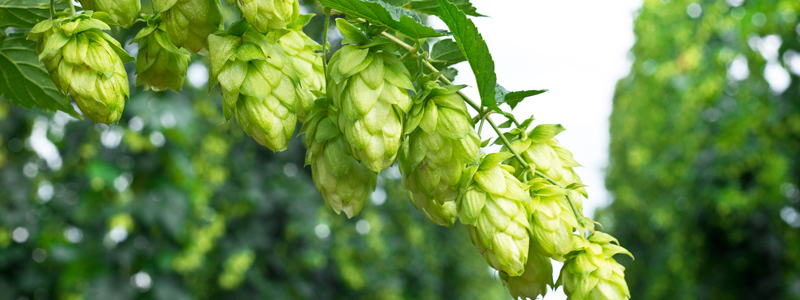It happens one day (or has it already?): someone at a party walks up to you, microbrew in hand, and starts expounding on the virtues of hops. A friend—maybe someone you trusted—chimes in. Suddenly you’re in the crossfires of a hops-off, listening as once familiar faces throw out strange names like Cascade, Fuggle, Nugget, and Galena. Names that sound like they belong in Harry Potter or the next dystopian teen trilogy, where Fuggle is the wizard, Nugget is the plucky best friend, and Cascade saves everyone with her secret blow-dart skills.
But before you scream, point out the window, and make a hasty exit while everyone looks to see what’s outside, consider the question: how much do you actually need to know about hops? As a beer lover, or maybe just a beer liker, do you really need to be ready to hold court in a craft beer hops-off?
On one hand, the craft beer industry is expanding (2014 saw its first double-digit share of the market), with styles continuing to evolve and diversify—thus, greater opportunity for nerding out. And craft beer culture does seem to nurture a certain hyperactive appetite for information. (If an event hall double-booked Comic Con and a craft beer festival, it’s a safe bet everyone would get along just fine. And that the perfect mascot of the resulting hybrid event would be Duff Man.) On the other hand, as anyone who loves, say, Cheetos and makes the mistake of reading the ingredients can tell you, there is a delicate dividing line between experience-enriching and experience-dulling information.
So do you surrender, tune in, and try to commit as much hops trivia as possible to memory? Not necessarily. Hop savvy really depends on where you exist in the beer world (more importantly, where you want to end up). What might be useful information for a brewer—say, that Centennial hops have a 9.5 to 11.5 percent alpha acid range—might make your eyes glaze over faster than the fine print on a tax form. More useful, or Hops 101, is knowing that thanks to that very acid (and some essential oils), hops impart aroma, flavor, and bitterness to beer as one of its essential ingredients (besides water, yeast, and starch). Whether you go for extra credit and memorize that those alpha acids come from the lupulin gland of the cone-shaped female hop flower, well, that’s between you, your beer, and any future Jeopardy aspirations.
The same goes for hop varieties. Since hops are generally blended for brewing, they’re kind of impossible to taste individually. Yes, the recent emergence of a few single-hop beers will actually showcase specific hops cultivars the way a Pinot Noir celebrates the singular glory of that one grape. But that’s hops-fringe-culture, and unless you live there, you’re better off knowing regional hops characteristics (hops flavors do move in herds, like those majestic dinosaurs of Jurassic Park). E.g., the blended hops in your West Coast IPA are more aggressively citrusy and piney—packing an unapologetic punch to your palate—while East Coast IPA will be subtler, more balanced out with malt, delivering something closer to a friendly hops noogie. And while you probably don’t need to know how to spell their consonant-chocked names, it is useful to know that the four “Noble” hops brewed into many European beers styles are lower acid (thus less bitter) and highly aromatic. Of course, if you’re up for any craft beer spelling bees, just remember there is an umlaut over the second “u” in Hallertaur Mittelfrüh.
Really, whatever level of hop-talk you see yourself engaging in at a party, the emphasis should be on buying well (especially as a looming barley shortage threatens to up the already higher price of a craft six pack. Craft beer drinkers have more choice, at higher cost, these days, and knowing hops is one way to navigate your way through that boozy cornucopia. So by all means, commit to memory that “wet hopping” is like using fresh herbs (brewing with just-picked, not kiln-dried hops), and that “fresh hopping” is actually just brewing with the most recently kiln-dried hops, while “dry hopping” involves adding kiln-dried hops to the keg after the boil, imparting no bitterness but lots of delicate hops flavor. Even if you’re not buying a hops-forward beer, it’s useful to know that hops are kind of always there, quietly hanging out in the background, giving structure and balance to, say, the rich chocolate stout you’re about to drink.
It’s not about discouraging exploration, just cutting through the craft intimidation. Proffering beer factoids like Altoids and enjoying beer are two very different, not necessarily related, things. For the industry, depth is essential, a useful way to distance itself from maybe too “accessible” stereotypes (think keg stands, Natty Ice, the Budweiser frogs); for beer drinkers, it’s optional, more often a passing phase, like when you fall for someone new. You can’t stop telling your friends about her, her favorite kind of chewing gum, the adorable way she always shifts her shoulder to block your line of sight as she enters her debit card pin. Three years down the road, you might forget her middle name. But that’s okay, because as long as you’re paying enough attention, she’ll always be, well, intoxicating.
Emily has been writing about food, drink, and the culture and politics thereof for several years now – despite all of which, she is still weirdly hungry and thirsty.

